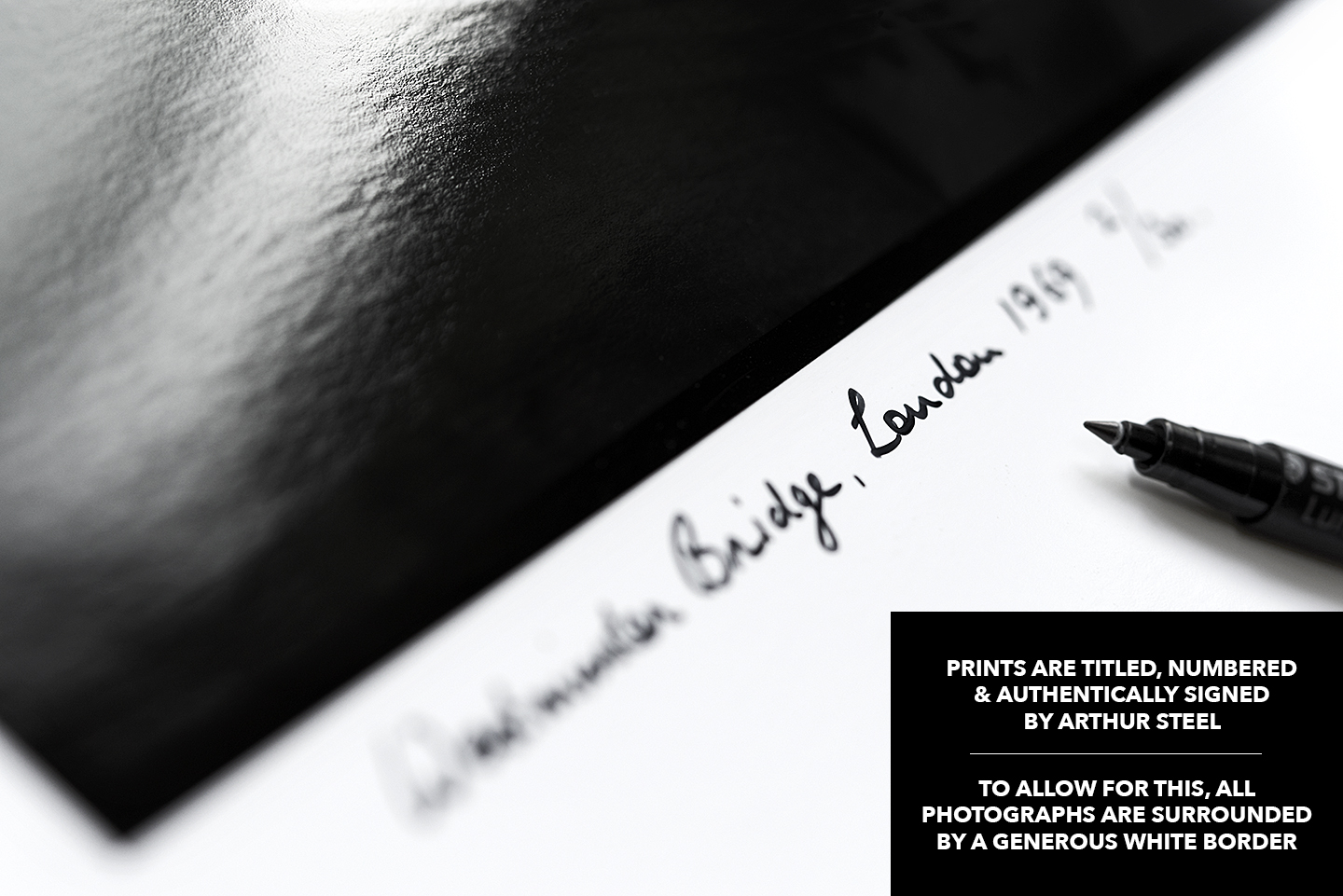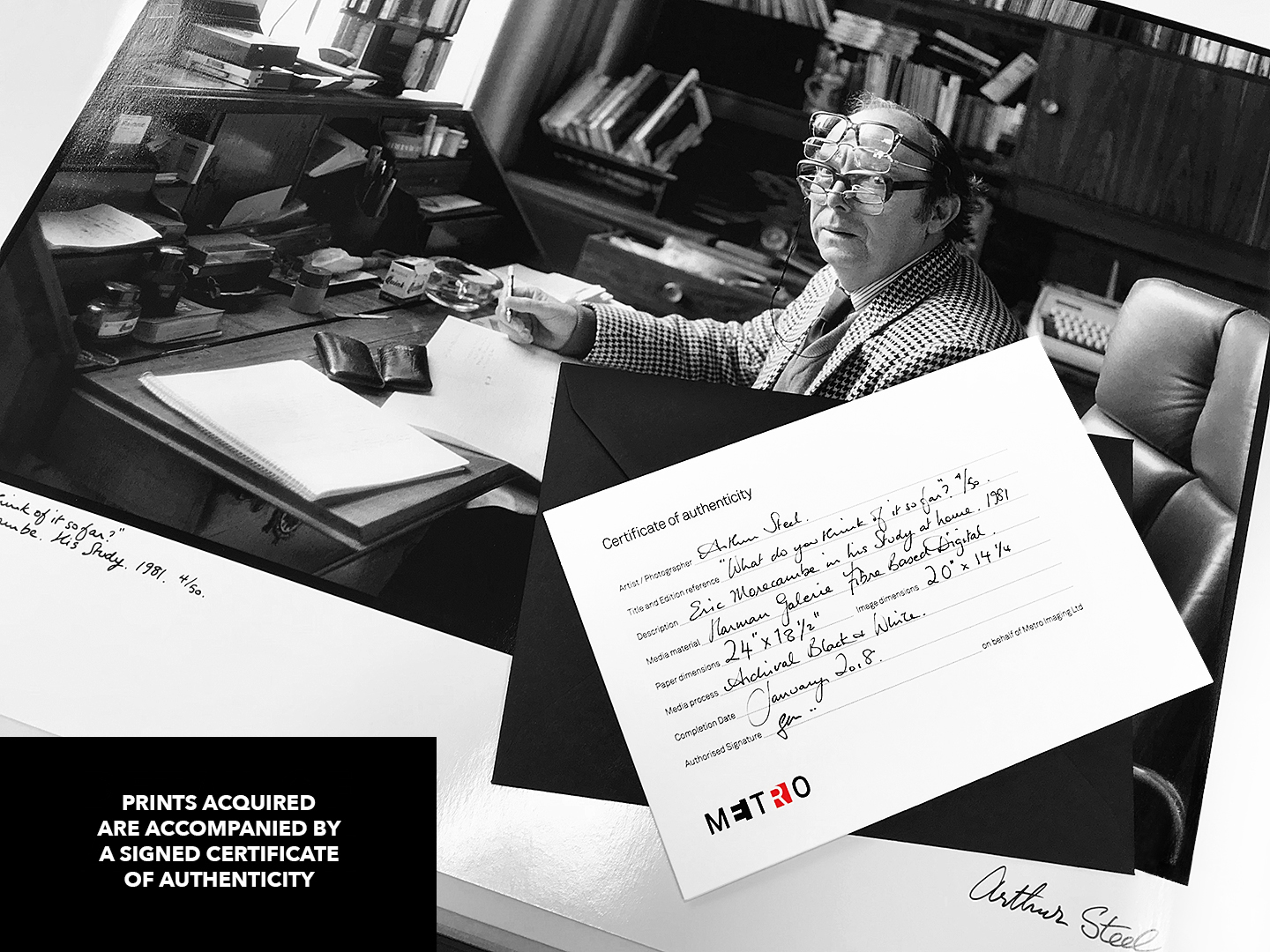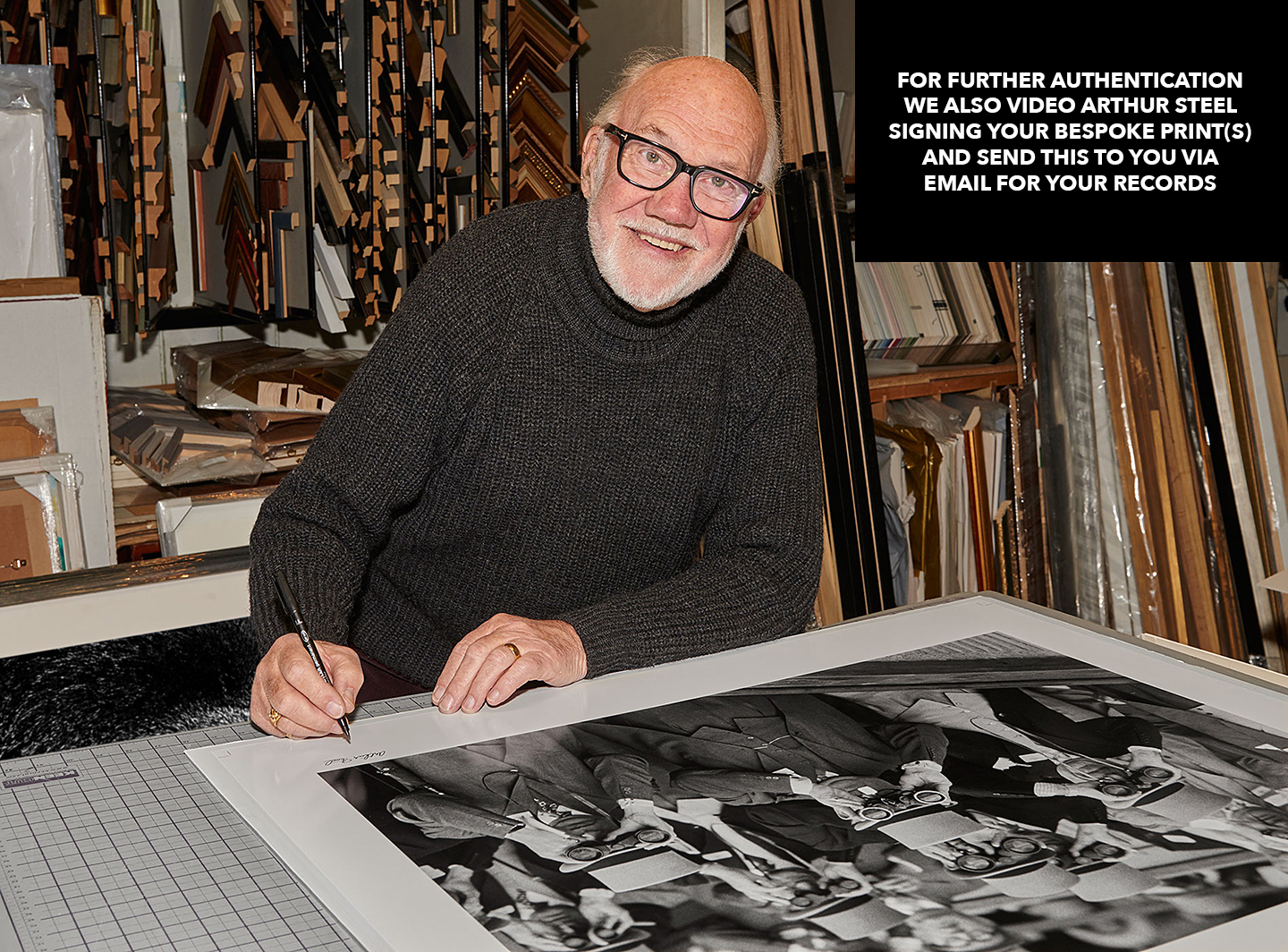Description
Charles, The Prince of Wales kisses Lady Diana Spencer on the balcony of Buckingham Palace on their Wedding day
One of the most instantly recognisable images in the world – the Charles and Di wedding kiss, 1981.
Arthur recalls: “Thank God I managed to capture it! It was so easy to miss – it happened so quickly and there was so much going on along the balconies. I had been given the rota position, representing the whole of the British Press. There were one hundred and fifty of the world’s best international press photographers on the Queen Victoria’s stand opposite Buckingham Palace and only three photographers managed to get the shot in the bag but my one was printed across the front page of all of the National Newspapers, even David Bailey missed it and he was standing next to me!”
Camera: Leicaflex SL2, 800mm, f6.3.
Film stock: Kodak Tri-X Pan.
Location: The balcony of Buckingham Palace overlooking The Mall
Year: 1981
Collection: Platinum
Print Type: Fibre-based Harman Galerie FB Digital
Printed by: Metro Imaging, London
Limited Editions:
All prints are limited editions, no further prints are produced once sold
50″ signed prints / edition of 10
40″ signed prints / edition of 20
30″ signed prints / edition of 30
20″ signed prints / edition of 50
12″ signed prints / edition of 50
Bespoke: All prints are bespoke and printed to order
Presentation & Delivery: 12 & 20 inch prints are titled, numbered, signed and carefully enfolded in acid free tissue paper, supplied flat in an acid free 4mm 3-ply box for delivery and storage purposes. The boxes are ideal for gift wrapping. The larger 30, 40 & 50 inch prints are also titled, numbered, signed and carefully enfolded in acid free tissue paper and inserted into a rigid 4mm thick protective cardboard tube for delivery. Metro Imaging based in Central London use an experienced shipping service to deliver the boxed and rolled prints. Metro take great care in ensuring the print(s) are very well protected and efficiently delivered anywhere in the UK or overseas. Acid free tissue paper protects prints from scratching/creasing. Metro also offer a vast array of delivery options to suit the recipient’s preference
Optional Dry Mounting: Professional Dry Mounting of the larger print sizes can be arranged at an additional cost, the print would then be perfectly flat and ready for framing. However, this makes the overall size very bulky for transporting, so, it may be best for us to send a rolled print directly to your framers and let them carry out the works. You just need to make sure that they are insured as we cannot take responsibility for any damages they may incur
Certificate of Authenticity: Each print acquired from The Arthur Steel Archive is accompanied by an individually signed Certificate of Authenticity
Video of Authenticity: Newly printed bespoke prints are further authenticated by way of a short personalised video. Arthur Steel mentions your name on the recording prior to signing. For example, Arthur will say something like: “I’m signing this print of Charles & Diana, edition number 2/20 for Mr & Mrs Smith in New York.” For your records, the footage is then sent to you via email
Watermark: Watermarks will not be present on an original print
Copyright: © Arthur Steel / News UK
‘This picture captures a magical moment in terms of how the public were viewing the famous marriage of Diana and Charles. It’s only in retrospect that it symbolises the crushed dream. The reality of the marriage was not how we saw it at the time.’
Alex Steele-Mortimer
‘What makes the photograph so poignant now is how the fairytale wedding turned into a nightmare. At the time it was about happiness, now it’s ultimate tragedy. It will always evoke the failure of the Royal Family towards the end of the century.’
Garry Coward-Williams
‘This was the moment that was over too quickly for television to represent and also for most of the photographers to capture. And yet it has become the symbol of the fairytale romance of the late 20th century.’
Mark Haworth-Booth
‘After so many hours of planning and waiting around for the “happy couple’’ to appear on the balcony, Arthur Steel was one of the few photographers who managed to get “the kiss”. It was just a peck, really, and it was over in just a blur. Many photographers, including myself, missed it.’
Eamonn McCabe
PICTURES OF THE CENTURY
The Pictures of the Century are selected by AP’s illustrious panel of experts, who bring expertise from all areas of photography.
ALEX STEELE-MORTIMER Studied fine art and art history in Canada and, since 1993, has been the gallery manager of the Association Gallery in London, with responsibility for running the gallery and organising all the exhibitions
GARRY COWARD-WILLIAMS Editor of Amateur Photographer. Worked as a professional advertising photographer in London from 1976 to 1985, before embarking upon a career in publishing
MARK HAWORTH-BOOTH Curator of photographs at the V&A, an author of many essential reference works on photography’s history and a man who has worked closely with many of the great photographers of modern times
EAMONN McCABE Multi-award winning picture editor of The Guardian newspaper, and previously a much-decorated and admired sports photographer for The Observer
Interview: ICONS OF PHOTOGRAPHY | ICONIC PHOTOGRAPH: THE KISS
Arthur Steel was one of the very few photographers to capture Charles and Diana’s famous wedding-day kiss. He tells David Clark how he did it
The apparently ‘fairy-tale’ wedding of Prince Charles and Lady Diana Spencer on 29 July 1981 was enthusiastically celebrated around the world. Approximately 600,000 people lined the wedding route on London’s streets, while an estimated worldwide audience of 750 million people watched events unfold on television. Thirty years on, it remains the most popular television programme ever broadcast
On the day, hundreds of photographers from national and international newspapers, magazines and media organisations covered the event. Many photographers were positioned outside St Paul’s Cathedral, where the marriage took place
However, at St Paul’s Charles and Diana seemed too nervous and preoccupied for photographers to capture the spontaneous, joyful images that newspapers wanted. As the day progressed, attention was focused on Buckingham Palace, where the newlyweds were due to appear on the balcony in the afternoon
Among the photographers positioned on the Queen Victoria Memorial, opposite Buckingham Palace, was Photographer Arthur Steel. As one of Fleet Street’s few representatives on Buckingham Palace’s select ‘royal rota’, he was supplying images for all the British daily newspapers
Arthur was then in his mid-40s and a seasoned press photographer, he was an accomplished all-rounder, experienced in tackling a range of assignments, including hard news stories, celebrity pictures, sport and fashion shoots
Arthur, now 74, has a clear memory of the day’s events. ‘The authorities had built an enclosure for press photographers on the Victoria Memorial, which consisted of three or four tiers of wooden boards on scaffolding,’ he says. ‘But when I went to choose my spot a couple of days prior to the event, I could see there was a problem’
Although the boards looked strong, as soon as Arthur walked on them he found that they were very springy. As the photographers would all be shooting with long lenses and resting their tripods on the boards, he realised that camera shake could potentially ruin many of the wedding pictures
Arthur chose the steadiest available spot, right at the end of one of the higher tiers, surrounded by a corner section. To give better support, he asked a builder friend to lend him a couple of pieces of scaffolding with a ‘coupler’ to join them on to the main scaffolding poles. This scaffolding, topped with a cushion, gave Arthur a much more stable surface on which to rest his camera
He was shooting with a Leicaflex, a fully manual SLR manufactured by Leitz, which was fitted with an 800mm lens. The lens weighed 7kg and at the time was worth £6,800. As a backup, Arthur also had a Nikon SLR with a 1,000mm lens attached, set up on a tripod. Both cameras were trained on the balcony and he fired them simultaneously using a double cable release
Although Charles and Diana were not due to appear until after 1pm, the photographers had to be in place by 8am to avoid the crowds. They were stationed on the four-tier enclosure, on the ground and inside the palace forecourt. Arthur was standing next to David Bailey. All the photographers were feeling the pressure
‘There wasn’t much conversation between us as there was a lot of double-checking of cameras, films and all that sort of thing,’ Arthur says. ‘We were all a bit strung out. I also found that even with the extra scaffolding support, if one of the other photographers coughed or sneezed or made any kind of movement, it could be observed down the lens’
Around five hours later, Charles and Diana appeared on the balcony to wave to the crowds. They made several appearances on the balcony and every time they went back inside Arthur re-loaded his cameras so he could avoid missing any of the action. The films were collected on an hourly basis by police, who took them through the crowds to a point where despatch riders would collect them and take them to be processed immediately
However, the photographers were still waiting to capture the one iconic moment that would symbolise the wedding. Then, during one if the balcony appearances, Charles and Diana leaned towards each other and momentarily kissed. It happened only once and was over so quickly that most of the photographers were caught off guard; of the 150 press photographers outside the Palace, only three are known to have captured the kiss
Arthur knew this would be the picture of the day and when he returned to the offices later in the evening he discovered that it was being used on the majority of the front pages of the major UK newspapers. Arthur had actually shot a wider scene that included other royal family members, but on the front page it was cropped to simply show Charles and Diana’s seemingly passionate kiss. His wily approach and careful planning, combined with his razor-sharp reactions, resulted in him capturing the royal wedding photograph that everyone remembers
Biography: Diana, Princess of Wales (Diana Frances; née Spencer; 1 July 1961 – 31 August 1997), was a member of the British royal family as the first wife of Charles, Prince of Wales, the heir apparent to the British throne. She was the mother of Prince William, Duke of Cambridge, and Prince Harry
Diana was born into the Spencer family, a family of British nobility with royal ancestry and was the youngest daughter of John Spencer, Viscount Althorp, and Frances Roche. She grew up in Park House, situated on the Sandringham estate, and was educated in England and Switzerland. In 1975—after her father inherited the title of Earl Spencer—she became known as Lady Diana Spencer. She came to prominence in February 1981 when her engagement to Prince Charles was announced to the world
Diana’s wedding to the Prince of Wales took place at St Paul’s Cathedral on 29 July 1981 and reached a global television audience of over 750 million people. During her marriage, Diana was Princess of Wales, Duchess of Cornwall, Duchess of Rothesay, and Countess of Chester. The marriage produced two sons, the princes William and Harry, who were then respectively second and third in the line of succession to the British throne. As Princess of Wales, Diana undertook royal duties on behalf of the Queen and represented her at functions overseas. She was celebrated for her charity work and for her support of the International Campaign to Ban Landmines. Diana was involved with dozens of charities including London’s Great Ormond Street Hospital for children, of which she was president from 1989. She also raised awareness and advocated ways to help people affected with HIV/AIDS, cancer, and mental illness
Diana remained the object of worldwide media scrutiny during and after her marriage, which ended in divorce on 28 August 1996. Media attention and public mourning were extensive after her death in a car crash in a Paris tunnel on 31 August 1997 and subsequent televised funeral
The Wedding: Thirty-five hundred guests made up the congregation at St Paul’s Cathedral. Charles and Diana selected St Paul’s over Westminster Abbey, the traditional site of royal weddings, because St. Paul’s offered more seating and permitted a longer procession through London.
The ceremony was a traditional Church of England wedding service, presided over by the Most Reverend Robert Runcie, Archbishop of Canterbury, and the Very Reverend Alan Webster, Dean of St. Paul’s Cathedral. An estimated 750 million people watched the ceremony worldwide, and this figure allegedly rose to a billion when the radio audience is added in, although there are no means of verifying these figures. Two million spectators lined the route of Diana’s procession from Clarence House, with 4,000 police and 2,201 military officers to manage the crowds.
All of the Queen’s governors-general, as well as Europe’s crowned heads, attended, with the exception of King Juan Carlos I of Spain. (The Spanish king was advised not to attend by his government because the newlyweds’ honeymoon included a stopover in the disputed territory of Gibraltar). Most of Europe’s elected heads of state were among the guests, with the exceptions of the President of Greece, Constantine Karamanlis (who declined because Greece’s exiled monarch, Constantine II, a kinsman and friend of the bridegroom, had been invited as “King of the Hellenes”), and the President of Ireland, Patrick Hillery (who was advised by Taoiseach Charles Haughey not to attend because of the dispute over the status of Northern Ireland)
First Lady Nancy Reagan represented the United States at the wedding.
Regiments from the Commonwealth realms participated in the procession, including the Royal Regiment of Canada.
Lady Diana arrived at the cathedral in the Glass Coach with her father, John Spencer, 8th Earl Spencer; she was escorted by six mounted Metropolitan Police officers. She arrived almost on time for the 11:20 BST ceremony. The carriage was too small to hold the two of them comfortably due to her voluminous dress and train. She made the three-and-a-half minute walk up the red-carpeted aisle with the sumptuous 25 ft (8 m) train of gown behind her
Diana accidentally changed the order of Charles’s names during her vows, saying “Philip Charles Arthur George” instead of the correct “Charles Philip Arthur George”. Charles also made an error. He said he would offer her “thy goods” instead of “my worldly goods”. She did not promise to “obey” him as part of the traditional vows. That word was eliminated at the couple’s request, which caused a sensation at the time
Other church representatives present who gave prayers after the service were a former Archbishop of Canterbury, Donald Coggan, Cardinal Basil Hume, the Right Reverend Andrew Doig and the Reverend Harry Williams CR
Three choirs, three orchestras and a fanfare ensemble played the music for the service. These were the Bach Choir, the Choir of St. Paul’s Cathedral, the Choir of the Chapel Royal, the Orchestra of the Royal Opera House, the Philharmonia Orchestra and the English Chamber Orchestra and a fanfare ensemble from the Royal Military School






Recent Comments